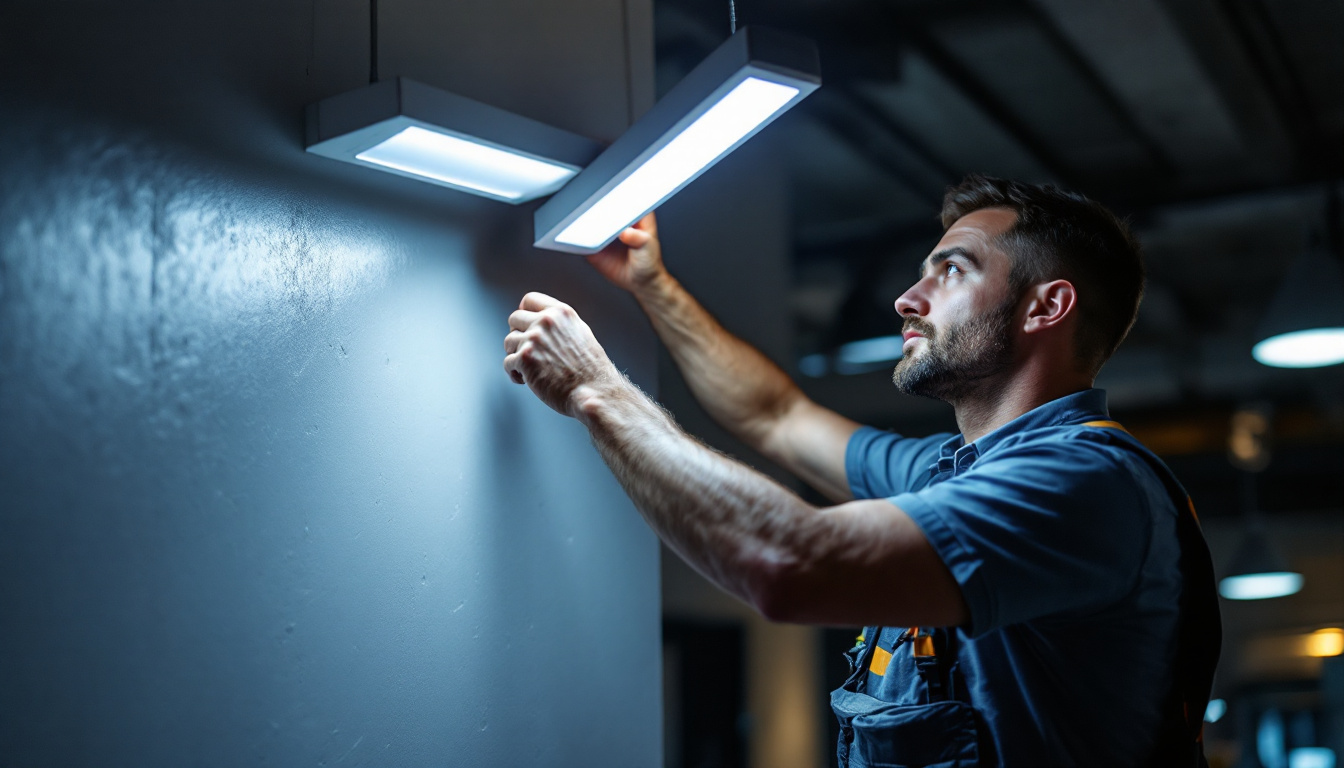
In the ever-evolving world of lighting solutions, LED 4-foot light fixtures have emerged as a popular choice for both commercial and residential applications. Their energy efficiency, longevity, and versatility make them an attractive option for lighting contractors. However, as with any technology, there are potential issues that can arise during installation and maintenance. This article explores common challenges faced by lighting contractors when working with LED 4-foot light fixtures and offers strategies to avoid them.
Before delving into specific issues, it is crucial for lighting contractors to have a solid understanding of LED technology. LEDs, or Light Emitting Diodes, differ significantly from traditional lighting solutions such as incandescent or fluorescent bulbs. Their unique properties can lead to both advantages and challenges in installation and performance.
One of the primary benefits of LED fixtures is their energy efficiency. They consume significantly less power than traditional lighting options, which translates to lower energy bills for clients. Additionally, LEDs have a longer lifespan, often lasting up to 50,000 hours or more. This longevity reduces the frequency of replacements, making them a cost-effective choice in the long run.
However, the very efficiency that makes LEDs appealing can also lead to issues if not properly understood. For instance, improper installation can lead to overheating, which can shorten the lifespan of the fixture. Therefore, it is essential for lighting contractors to be aware of the thermal management requirements of LED technology. Understanding heat sinks and proper ventilation techniques can be critical in ensuring that the fixtures operate within their optimal temperature range, thus maximizing their lifespan and performance.
Another aspect of LED technology that contractors must grasp is color temperature. LEDs are available in a range of color temperatures, from warm white to cool daylight. The choice of color temperature can significantly impact the ambiance of a space and should align with the client’s preferences and the intended use of the area.
Moreover, the quality of light emitted by LEDs can vary. Not all LED fixtures are created equal; some may produce a harsh or flickering light, which can be detrimental to the overall aesthetic and functionality of a space. Contractors should prioritize high-quality products from reputable manufacturers to ensure client satisfaction. Additionally, understanding the Color Rendering Index (CRI) is essential, as it measures how accurately a light source displays colors in comparison to natural light. A higher CRI rating indicates better color accuracy, which is particularly important in settings such as retail stores or art galleries, where the true representation of colors is vital for both aesthetics and sales.
Even with a solid understanding of LED technology, installation can present challenges. Lighting contractors often encounter issues that can lead to delays, increased costs, and dissatisfied clients. Here are some common installation problems and how to avoid them.
One of the most frequent issues encountered during installation is inadequate wiring. LED fixtures require specific wiring configurations to function correctly. If the existing wiring is not compatible, it can lead to flickering lights, reduced performance, or even complete failure of the fixture.
To avoid this issue, contractors should conduct a thorough assessment of the existing electrical infrastructure before installation. This includes checking the gauge of the wiring, ensuring compatibility with the LED fixtures, and making any necessary upgrades to the electrical system. Proper planning can save time and money in the long run. Additionally, understanding the load requirements of the LED fixtures is crucial. Many contractors overlook the importance of load calculations, which can lead to overloading circuits and potential safety hazards. By ensuring that the wiring can handle the electrical load, contractors can prevent future complications and ensure a smooth installation process.
Another common issue is improper mounting techniques. LED fixtures can be sensitive to how they are installed, and incorrect mounting can lead to misalignment, reduced light output, or even damage to the fixture itself. For example, mounting fixtures too close to heat sources can cause overheating and premature failure.
To mitigate these risks, it is advisable for contractors to follow the manufacturer’s installation guidelines meticulously. Additionally, using the right tools and hardware for mounting can ensure that fixtures are securely installed and positioned correctly to maximize light output. It’s also important to consider the environment in which the fixtures will be installed. Factors such as humidity, temperature fluctuations, and exposure to elements can affect the longevity and performance of LED fixtures. For outdoor installations, using weather-resistant fixtures and ensuring proper sealing can prevent moisture ingress, which is a common cause of failure. By taking these environmental factors into account, contractors can enhance the durability and efficiency of the lighting system.
After installation, performance issues can still arise, leading to client dissatisfaction and potential callbacks for contractors. Understanding how to address these issues is crucial for maintaining a good reputation and ensuring repeat business.
Flickering lights are a common complaint among clients after installation. This issue can be caused by several factors, including incompatible dimmers, poor connections, or voltage fluctuations. Identifying the root cause is essential for resolving the problem effectively.
To prevent flickering, contractors should recommend compatible dimmers designed for LED fixtures. Additionally, ensuring that all connections are secure and that the electrical supply is stable can help mitigate this issue. If flickering persists, it may be necessary to consult with an electrician to evaluate the electrical system further.
Moreover, it is beneficial for contractors to educate clients about the importance of using high-quality wiring and components. Low-grade materials can lead to increased resistance, which may contribute to flickering. Regular maintenance checks can also be suggested to clients, ensuring that any potential issues are caught early before they escalate into more significant problems.
Color shifting is another performance issue that can arise with LED fixtures. Over time, some LEDs may change color, leading to an inconsistent appearance in a lighting scheme. This can be particularly problematic in commercial settings where uniformity is crucial.
To minimize the risk of color shifting, contractors should source fixtures from reputable manufacturers that provide consistent color quality. Additionally, it is advisable to use fixtures from the same production batch to ensure uniformity in color temperature and quality.
Furthermore, educating clients about the factors that can contribute to color shifting is essential. For instance, exposure to extreme temperatures or humidity can affect LED performance. Contractors should also recommend the use of fixtures with a higher Color Rendering Index (CRI) to ensure that colors remain true and vibrant over time. By being proactive and providing clients with this knowledge, contractors can enhance customer satisfaction and reduce the likelihood of future complaints related to color consistency.
Regular maintenance is essential for ensuring the longevity and performance of LED fixtures. Lighting contractors should educate their clients on the importance of maintenance and offer services to help keep their lighting systems in optimal condition.
One often-overlooked aspect of LED maintenance is cleaning. Dust and debris can accumulate on fixtures, reducing light output and affecting the overall performance. Regular cleaning can help maintain brightness and extend the life of the fixtures.
Contractors should recommend a cleaning schedule to their clients, emphasizing the importance of using appropriate cleaning materials that will not damage the fixtures. Soft cloths and non-abrasive cleaners are typically the best options for maintaining the integrity of LED fixtures.
In addition to regular cleaning, monitoring for performance issues is essential. Contractors can offer to conduct periodic inspections to identify any potential problems before they escalate. This proactive approach can save clients money in the long run and enhance the contractor’s reputation for reliability and quality service.
Not all LED 4-foot light fixtures are created equal. Lighting contractors must be discerning when selecting products for their projects. The right choice can significantly impact installation ease, performance, and client satisfaction.
When selecting LED fixtures, quality should be a top priority. Contractors should look for products that have been certified by recognized organizations, such as the Underwriters Laboratories (UL) or the DesignLights Consortium (DLC). These certifications ensure that the fixtures meet specific safety and performance standards.
Additionally, investing in high-quality fixtures can reduce the likelihood of issues arising during installation and throughout the fixture’s lifespan. While the initial cost may be higher, the long-term benefits often outweigh the expense.
Every client has unique requirements and preferences when it comes to lighting. Understanding these needs is crucial for selecting the right fixtures. Contractors should engage in thorough discussions with clients to determine their specific goals, whether it be energy savings, aesthetic preferences, or functional lighting needs.
By aligning product choices with client expectations, contractors can enhance satisfaction and foster long-term relationships. Offering tailored solutions demonstrates professionalism and expertise, which can lead to referrals and repeat business.
LED 4-foot light fixtures offer numerous benefits, but they also present challenges that lighting contractors must navigate. By understanding LED technology, addressing common installation and performance issues, and prioritizing quality in product selection, contractors can avoid many of the pitfalls associated with these fixtures.
Ultimately, the key to success lies in proactive planning, ongoing education, and a commitment to quality service. By adopting these best practices, lighting contractors can ensure that their projects are completed smoothly, resulting in satisfied clients and a thriving business.
Ready to elevate your lighting projects with the best LED 4-foot light fixtures on the market? Look no further than LumenWholesale, where we provide contractors with superior, spec-grade lighting products at unbeatable wholesale prices. Say goodbye to local distributor markups and hello to our extensive selection that meets the highest industry standards. With LumenWholesale, you get the reliability and high performance your clients demand, paired with the convenience of hassle-free bulk buying and free shipping. Don’t compromise on quality or value—Wholesale Lighting at the Best Value is just a click away. Make the smart choice for your business and your clients with LumenWholesale.

Discover essential compliance insights for lighting contractors in this comprehensive guide.

Discover essential insights for lighting contractors on high bay lighting solutions.

Discover how poles for yard lights can transform your outdoor lighting projects from ordinary to extraordinary.

Discover essential tips for lighting contractors to create eye-friendly desktop environments.